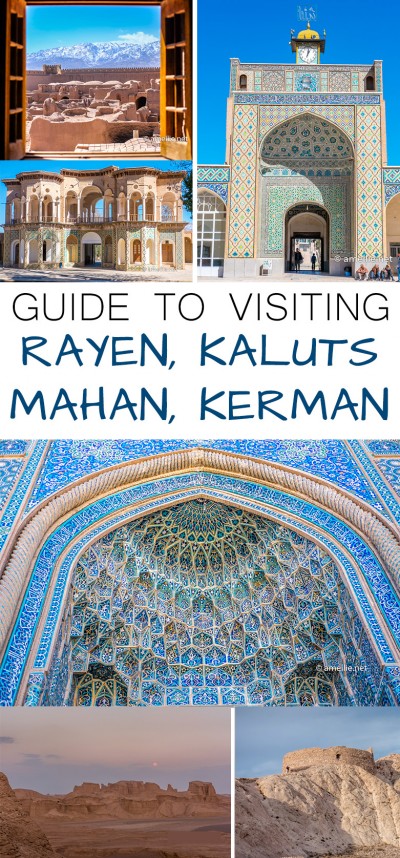- Best of Iran: The Perfect 15-Day Itinerary For Your Life-Changing Trip
- Essential Guide to Applying for an Iranian Visa
- Surviving Tehran: A Practical Backpacker’s Guide
- Visiting Tochal: A Mountain That Looms Over Tehran
- 4 Local Restaurants You Have to Try in Tehran, Iran
- 24 Hours in Tehran: Through the Eyes of Locals
- 5 Great Places to Explore in Tehran, Iran
- Yazd: How to Get the Most Out of Your Visit to an Iranian Tatooine (with useful tips!)
- A Day Trip to Abyaneh: Iran’s Most Beautiful Ancient Village
- Exploring Iran’s Persepolis & Necropolis: The Impressive Legacy of the Achaemenid Empire
- Kerman’s Hidden Gems: Guide to Visiting Rayen, Kaluts, Mahan, and Kerman City
- Plan Your Visit to Kerman, Kaluts, Mahan, Rayen, and Bam – with useful tips!
Kerman Province is Iran’s second largest province. Situated in the southeast of Iran, it is home to diverse landscapes from deserts, mountains, historical cities, and ancient citadels. The hottest place on earth, Dasht-e Lut Desert or Kaluts, can be found in Kerman. The region also inherits a long history of human settlements which goes back to the fourth millennium BC. Historically, it was part of the region of the Achaemenid Empire, known as Carmania, with mining (silver, copper, ochre, orpiment, and salt) as its source of contribution to the empire.
I came to Kerman without any expectations. In fact, there was not much information about this region on the Internet and it is hard to imagine what I would find here. Surprisingly, Kerman has really exceeded my expectations. I was surprised by its landscape! It is a pity that not many people visit this beautiful region. A lot of people would go from Yazd to Shiraz (or vice versa) by skipping Kerman, and I can tell you with confidence that they are missing quite a lot of things! If you have the time, do stop by in Kerman and discover the secrets that this unique province can offer.
Kerman City
Kerman is the capital city of Kerman Province. Famous for its strong cultural heritage, the city is one of the oldest in Iran. It is well-known for its thriving hand-woven carpet industry since the late 19th century. Just like Yazd, it has a sizable number of Zoroastrians here with at least two fire temples exist in the city.

Due to the ancient history, Kerman has a lot of tourism potentials that have not been properly tapped and promoted. A lot of visitors come here mainly to go to Rayen, Kaluts, or Bam. But the city itself has a number of interesting historical places that should not be missed out :). We are lucky to be accompanied by our Iranian friends Mustafa and Kiyana, showing us different sides of Kerman and introducing us to life-changing foods!
How to get in/out of Kerman
The city of Kerman can be reached by bus from Yazd for 320,000 rials per person. It takes about 4-5 hours to get there from Yazd. It can also be reached from other major cities, including Shiraz and Bandar Abbas.
Kerman can also be reached by train, which takes about 2 hours longer than the bus journey, costing at least 300,000 rials one way from Yazd. There are train services between Yazd – Kerman – Bam. However, there are no services between Kerman – Shiraz – Bandar Abbas. The only way to get to those cities is by buses.
What to do
Tower of Silence
The main highlight of our visit to Kerman was definitely the Tower of Silence. Just like the one in Yazd, this is an important site where the followers of the ancient religion of Zoroastrian laid their dead to be exposed to birds and other creatures. Zoroastrians believe that dead bodies are unclean and therefore, they should not be buried as they would pollute the earth. This practice, however, has been banned in Iran since the 1970s, leaving most of the towers abandoned.
Read more: Yazd: How to Get the Most Out of Your Visit to an Iranian Tatooine
The Tower of Silence that we visited in Kerman is slightly different than the one in Yazd. This circular structure, built atop hills, is completely deserted with a 360-degree view of the vast landscape! There were no tourists — only one or two locals were there. The tower is slightly ruined (but that’s what makes it special!). You can even find some human remains lying around on this hill, including human bones, fragments of skulls, and teeth — if you have sharp eyes, of course 🙂

As the tower is located in the outskirt of Kerman, you would need a taxi to get there. I am not sure how much the fare would be though, as we went there with our local Iranian friends Mustafa and Kiyana. It is located nearby the Balad Al Amin University (Google Maps). The road up until the university is good, and as soon as you pass through pistachio fields, then it starts with gravel road for a few minutes until you reach the tower. Here’s the exact location of the tower:
- Entrance fee: Free! (until they decide to renovate it, I guess?)
- Location: Google Maps
Jame Mosque
Located near the bazaar, Jame Mosque is the main mosque of Kerman. It was built in 1350 during the Muzaffarid dynasty.
Compared to other mosques in Iran that I’ve visited, it has some unique features: a clock at the top of the iwan (the rectangular facade) and the extraordinary blue-turquoise tile designs. Just like the Sheikh Lotfollah Mosque in Esfahan, Jame Mosque does not have minarets.
- Entrance fee: ?
- Location: Kerman (Google Maps)
Ganjali Khan Complex
This huge complex was named after the governor of Kerman, Ganj Ali Khan, who ruled during the Safavid period. The complex occupies an area of 11,000 m2 and consists of a square, a bathhouse (hammam), a caravanserai, a school, a water reservoir, a mosque, and a bazaar (among other things!).
The Ganjalikhan Bathhouse is located along a section of Vakil Bazaar on the southern side of Ganjali Square. It is divided into 3 different parts: dressing room, hot chamber, and cold chamber. The dressing room has 6 chambers, dedicated for people with different social statuses. The ceiling interior of the bathhouse is designed with impressive symmetrical arches and columns with a few openings, allowing the light to enter and reflect on the water.
- Entrance fee to the bathhouse:
- Foreigner: 150,000 rials (USD 4.6)
- Local: 25,000 rials
- Location: Google Maps
Bazar-e Sartasari
Kerman’s magnificent ‘Sartasari’ (‘end-to-end’) Bazaar is one of the oldest trading centres in Iran. According to our friend Mustafa, it is also famous for being the longest bazaar in Iran. It consists of a few smaller bazaars and it connects to the Ganjali Khan buildings.
Unlike the bazaar in Esfahan where it is mostly occupied by souvenir shops, the bazaar here still sells traditional goods and you can see many locals do their errands here. It’s a lively bazaar, although not as crowded as the Grand Bazaar of Tehran.
Moshtagh Ali Shah Tomb or Moshtaghiye
Moshtagh Ali Shah was an 18th-century Sufi mystic. He is also known as a musician who introduced the fourth string on the setar, an Iranian traditional three-stringed guitar. Unfortunately, he was stoned to death in the Jame Mosque by religious people after they caught him singing some verses of the Qur’an to the tunes of his setar.
Built during the Qajar period in the 19th century, Moshtaghiye hosts a number of tombs of major Sufis, including Moshtagh Ali Shah himself. The building is famous for its three bulbous domes.
Where to eat and drink
Mirdarbari Restaurant
Our local friends, Mustafa and Kiyana brought us to this fancy restaurant. As it is located on the highest floor of the building, we could see the view of Kerman with a backdrop of mountains from the restaurant.
We were not only pampered with the beautiful view, but also the super delicious foods! Mustafa ordered different types of kebabs and ribs and I have to stay that this was the best kebabs I had ever tasted in Iran. The kebabs were juicy and flavourful! It was amazing! Check our vlog to see more of the restaurant.
Unfortunately, we were not allowed to pay the meals so I didn’t actually know how much the foods cost.
- Opening hours: Saturday to Friday 7:00 am to 10:00 pm
- Location: Atlas Building, Beheshti 7, Beheshti Street, Kerman (Google Maps)
- Phone: +98 (0)34 324 49600
- Website: Instagram
Vakil Teahouse and Restaurant (Hammam-e Vakil Chaykhaneh)
This is actually a traditional tea house which used to be a hammam (bathhouse). It had a warm and welcoming atmosphere, with a beautiful traditional interior. If you are lucky, a live traditional music accompanies you while enjoying a cup of tea.
Vakil Teahouse was the perfect place to get ourselves recharged again after the whole day of exploring Kerman. We sat here to enjoy the music and drank tea. The restaurant could be a good lunch or dinner option as it is located inside the Vakil Bazaar. We didn’t get to try the food here though!
- Opening Hours: 12:30 pm to 3:30 pm and 8:00 pm to 12:00 am
- Location: Vakil Bazaar, Kerman (Google Maps)
- Phone: +98 34 1222 5989
Where to stay
Akhavan Hotel
The hotel is not located nearby the tourist attractions, but we stayed here due to the good reviews and the cheap tour packages to Kaluts, Rayen, and Bam that the hotel offer.
The nightly rate for Akhavan Hotel is USD $40 for a double room with a private bathroom, which includes breakfast. I think it’s quite a decent and clean hotel with a nice and helpful guy at the reception. Although I would strongly suggest against eating at the restaurant of the hotel for dinner or lunch as it is not worth the price. They just heated the kebabs and I could taste the unfreshness of the kebabs! There is a restaurant opposite of the hotel (slightly towards the east of the hotel – Google Maps). Another nearby restaurant is the Max Restaurant, which is rated as one of the best restaurants on TripAdvisor. We didn’t manage to visit those restaurants though.
- Location: Tehran Road, Kerman (Google Maps)
- Phone: +98 34 3244 1411
Mahan
Mahan is a small town located next to Kerman. It only takes half an hour by car to reach this quiet town. According to our friend, Mahan is a favourite gateway town, often visited by local Kermanis in the weekend.
This town provided us with laidbackness that we had been deprived of ever since we started our travel in Iran a week earlier. We had been travelling and meeting people non-stop, and often time we had a sleep deprivation as we were enjoying our time in different places in Iran (not complaining though!). Going to Mahan was a perfect choice to finally recharge our energy again. We spent most of our day sleeping and exploring the town slowly. We really enjoyed our stay here!
How to get in
Mahan is reachable by minibus or shared taxi (savari) from Kerman’s Khajoo Square (Google Maps) for around 50,000 rials.
What to do
Shah Nimatullah Wali Shrine
Shah Nimatullah was a Sufi Master and poet from 14th and 15th centuries. He is revered by Shi’a as a saint. Hence, his shrine, which was built 5 years after his death and located just next to our hotel, became a pilgrimage site. The shrine complex consists of a garden, a mosque, and his tomb. Unfortunately, the entrance cost of 150,000 rials (USD 4.6) is expensive, in comparison to other sites that we’ve visited. Although it is quite nice to see the tomb and learnt how he spent most of his time, I would consider skipping this next time.
- Entrance fee: 150,000 rials (USD 4.6)
- Location: Google Maps
Shahzadeh Garden
When going to Iran, visiting Persian gardens is definitely part of your itinerary. Among the famous gardens that I visited are Fin Garden in Kashan and Eram Garden in Shiraz. Even if you don’t specifically go to those gardens, you will be able to see it in Golestan Palace in Tehran, Chehel Sotoun in Esfahan, and many other places of attractions, as they are one of the most important elements of Persian architecture.
Even though I have been to a few Persian gardens, I have to say that nothing was as beautiful and stunning as the Shahzadeh Garden in Mahan. The garden was built in the 1900s under the orders of the governor of Kerman during the Qajar dynasty and was eventually used as a summer residence.
What makes this garden so unique compared to other Persian gardens is that it has an impressive water cascade feature, which allows the water to flow from the upper ends towards the lower ends. The water itself comes from the nearby mountain. During winter, the snow-capped mountains surround the landscape of this beautiful garden. It’s astonishing to know that the water flows without the need of mechanical water pumps — and yes, this includes the fountains!
With the area covering more than 5.5 hectares, Shahzadeh Garden is rectangular in shape. There is a cafe/restaurant at the top part of the garden, next to the palace, where you can chill and enjoy the view. This garden is definitely not to be missed!
- Entrance cost:
- Foreigner: 200,000 rials (USD 6.2)
- Local: 30,000 rials
- Location: Mahan (Google Maps)
Where to stay
Eyvan Mahan Hotel
A lot of travellers would prefer to stay in Kerman as it is the centre of everything. However, if you want a peaceful and quiet place with not much going on around the town, then you can opt to stay in Mahan.
My husband and I were lucky that we have a friend in Kerman. He had just started doing travel business and was due to officially open a brand new traditional hotel in Mahan. When he picked us up in Kerman’s bus station, we actually thought we would be staying at his place. But to our surprise, he brought us to Mahan and made us the first ever guest to stay at Eyvan Hotel.
The hotel is located next to Shah Nimatullah Wali Shrine. In fact, we could see the shrine complex from our rear balcony of our room! We were given a room with the most beautiful view ever, a snow-capped mountain.
- Website: http://eyvanhotel.com/
- Phone: +98 (0) 34 337 789 56 / +98 (0) 34 337 789 55
- Email: eyvan.hotel@gmail.com
Rayen
Rayen is a small town located about 105 kilometres away from the Kerman city. The town is famous for its medieval castle.
How to get in
Rayen is reachable by bus from the Kerman bus terminal and by shared taxi (savari) from Sarasiyab Square.
What to Do
Rayen Citadel (Arg-e Rayen)
The medieval mudbrick city of Rayen is believed to have existed since 1,000 years ago. It was situated on a trade route, where high-quality textiles were traded. The citadel of Rayen is well-preserved and it looked “too nice” that it didn’t feel medieval at all. It was a great experience to explore every nook and cranny of this medieval city, though. We could even climb to the top of the castle to see the whole view. It was definitely worth paying 150,000 rials for the entrance ticket!
- Entrance fee: 150,000 rials (USD 4.6)
- Location: Rayen (Google Maps)
Kaluts
Kaluts, otherwise known as Dasht-e Lut Desert, is one of the largest deserts in the world. Part of the desert is widely known as the world’s hottest and driest place, with a temperature that can reach as high as 70 degrees Celsius in the summer. It’s no surprise that no vegetations or animals can live and flourish in this environment. The locals told me that even bacteria cannot grow here.
 Kaluts is about a 150-kilometre distance to the northeast of the main city of Kerman. The journey from Kerman to Kaluts is very scenic. It starts with a vast desert with snowy mountains in the background (only in the winter though). A valley then appears as you drive up towards the mountain. Before you know it, you are making your way through a mountain pass — you can even see snow here in the winter! Then the altitude decreases rapidly as you drive down the hill towards the desert. The weather dramatically changes from this point onwards — it is hotter and drier. Welcome to the hottest place on earth!
Kaluts is about a 150-kilometre distance to the northeast of the main city of Kerman. The journey from Kerman to Kaluts is very scenic. It starts with a vast desert with snowy mountains in the background (only in the winter though). A valley then appears as you drive up towards the mountain. Before you know it, you are making your way through a mountain pass — you can even see snow here in the winter! Then the altitude decreases rapidly as you drive down the hill towards the desert. The weather dramatically changes from this point onwards — it is hotter and drier. Welcome to the hottest place on earth!
Unfortunately, we spent too much time in Rayen Citadel (I do love that castle so much!) and waited for so long for our lunch that we ended up rushing for Kaluts. Our driver drove so fast to make sure we get to the destination. Thankfully, we managed to arrive a few minutes before the sunset.
We went to the top of a giant rock and viewed the desert filled with “sand castles”. Subhanallah, it was a magnificent landscape, something that I had never seen before. I’ve never been to Grand Canyon before so this was AMAZING! I wish I could spend more time here before the sun disappears though. The desert was completely dark at night (d’oh?!), except for the full moon that brightened the vast barren land. I also wanted to take pictures of the stars, but the moon lit up the dark sky, so I was not able to take a proper starry picture. Oh well, I wasn’t lucky! But I’m glad we visited Kaluts.
Just when we thought we were going home, our driver brought us to see a salt lake, which we barely could see. But it’s amazing to know that this lake exists in such dry condition! This earth is full of secrets that always make me surprised 🙂
Our Vlogs
Kerman
Rayen & Kaluts
Sources:




